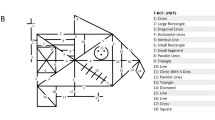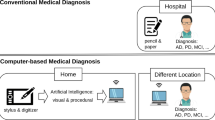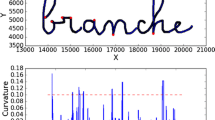Abstract
The aim of the study was to examine the application of a computerized handwriting model for characterizing complex figure-drawing performance. We posit that spatial, temporal, and pressure measures that reflect figure-drawing behavior will differ significantly under two mental workload conditions, and that both drawing and handwriting process measures will predict the quality of what is drawn and/or written. Thirty participants copied the Rey–Osterrieth Complex Figure Test (ROCFT). They then reproduced it from memory and finally copied a paragraph on a digitizer that is part of the Computerized Penmanship Evaluation Tool (ComPET) system. Results indicated that certain computerized measures of the ROCFT copying significantly correlated with those of the paragraph-copying behavior (r = .38–.75). Significant differences were found between the spatial and temporal computerized measures of performance in the ROCFT copying and drawing-from-memory tasks. Stepwise regressions indicated that mean pressure predicted 12 % of the variance of the ROCFT and paragraph-copying quality scores and 6 % of the ROCFT drawing-from-memory score. Furthermore, 52 % of the variance of the ROCFT drawing-from-memory score was predicted by the mean velocity. The benefits and significance of obtaining computerized measures of the drawing process for better insight about human performance characteristics are discussed, and applications are suggested.


Similar content being viewed by others
References
Squartini S, Hu S, Liu Q. Advances on brain inspired computing. Cogn Comput. 2013;5:161–3.
Zhao Z, Chen Z, Chen Y, Wang S, Wang H. A class incremental extreme learning machine for activity recognition. Cogn Comput. 2014;6:423–31.
Taylor JG. Cognitive computation. Cogn Comput. 2009;1:4–16.
Cambria E, Hussain A. Sentic computing: techniques, tools, and applications. Springer briefs in cognitive computation. Dordrecht: Springer; 2012.
Hussain A, Niazi M. Toward a formal, visual framework of emergent cognitive development of scholars. Cogn Comput. 2014;6:113–24.
TraviesoCM, Alonso JB. Special issue on advanced cognitive systems based on nonlinear analysis. Cogn Comput. 2013;5:397–8.
McClelland JL. Is a machine realization of truly human-like intelligence achievable? Cogn Comput. 2009;1:17–21.
Stone JV. Learning perceptually salient visual parameters using spatiotemporal smoothness constraints. Neural Comput. 1996;8:1463–92.
Malik ZK, Hussain A, Wu J. Novel biologically inspired approaches to extracting online information from temporal data. Cogn Comput. 2014;6:595–607.
Faundez-Zanuy M, Hussain A, Mekyska J, Sesa-Nogueras E, Monte-Moreno E, Esposito A. et al. Biometric applications related to human beings: there is life beyond security. Cogn Comput. 2013;5:136–51.
Squartini S, Esposito A. CO-WORKER: toward real-time and context-aware systems for human collaborative knowledge building. Cogn Comput. 2012;4:157–71.
Kandel S, Valdois S. Syllables as functional units in a copying task. Lang Cogn Proc. 2006;21:432–52.
Longstaff MG, Heath RA. The influence of motor system degradation on the control of handwriting movements: a dynamical systems analysis. Hum Mov Sci. 2003;22:91–110.
Poon KW, Li-Tsang CWP, Weiss TPL, Rosenblum S. The effect of a computerized visual perception and visual-motor integration training program on improving Chinese handwriting of children with handwriting difficulties. Res Dev Disabil. 2010;31:1552–60.
Werner P, Rosenblum S, Bar-On G, Heinik J, Korczyn A. Handwriting process variables discriminating mild Alzheimer’s disease and mild cognitive impairment. J Gerontol B Psychol Sci Soc Sci. 2006;61:228–36.
Rosenblum S, Dekel T, Gurevitz I, Werner P, Heinik J. Handwriting process variables among elderly people with mild major depressive disorder: a preliminary study. Aging-Clin Exp Res. 2010;22:141–7.
Luria G, Rosenblum S. A computerised multidimensional measurement of mental workload via handwriting. Behav Res Meth. 2012;44:575–86.
Luria G, Kahana A, Rosenblum S. Detection of deception via handwriting behaviors using a computerized tool: toward an evaluation of malingering. Cogn Comput. 2014;6(4):849–55.
Sesa-Nogueras E, Faundez-Zanuy M, Mekyska J. An information analysis of in-air and on-surface trajectories in online handwriting. Cogn Comput. 2012;4:195–205.
Rey A. L’examenpsychologiquedans les casd’encephalopathietraumatique. Arch Psychol. 1941;28:286–340.
Osterrieth P. The test of copying a complex figure: a contribution to the study of perception and memory. Arch Psychol. 1944;30:206–356.
Caffarra P, Vezzadini, Dieci F, Zonato F, Venneri A. Rey–Osterrieth complex figure: normative values in an Italian population sample. Neurol Sci. 2002;22:443–7.
Baddeley AD, Hitch GJ. Working memory. In: Bower GH, editor, The psychology of learning and motivation. New York: Academic Press; 1974. pp. 47–89.
Baddeley AD. Working memory: looking back and looking forward. Nat Rev Neurosci. 2003;4:829–39.
Longstaff MG, Heath RA. A nonlinear analysis of the temporal characteristics of handwriting. Hum Mov Sci. 1999;18:485–524.
Chartrel E, Vinter A. The impact of spatio-temporal constraints on cursive letter handwriting in children. Learn Instr. 2008;18(6):537–47.
Cegarra J, Chevalier A. The use of Tholos software for combining measures of mental workload: Toward theoretical and methodological improvements. Behav Res Methods. 2008;40(4):988–1000.
Wickens CD. Multiple resources and performance prediction. Theor Issues Ergon Sci. 2002;3(2):159–77.
Luria G, Rosenblum S. Comparing the handwriting behaviors of true and false writing with computerized handwriting measures. Appl Cogn Psychol. 2010;24:1115–28.
Bi S, Salvendy G. Analytical modeling and experimental study of human workload in scheduling of advanced manufacturing systems. Int J Hum Factor Man. 1994;4:205–34.
Sheridan TB. Risk, human error, and system resilience: fundamental ideas. Hum Factors. 2008;50(3):418–26.
Cassenti DN, Kelley TD, Carlson RA. Modeling the workload-performance relationship. In: Proceedings of the human factors and ergonomics society annual meeting. Beverly Hills, CA: SAGE; 2010. Vol. 54, No. 19, pp. 1684–8.
Reason J. How necessary steps in a task get omitted: revising old ideas to combat a persistent problem. Cogn Technol. 1998;3:24–32.
Cahill SM. Where does handwriting fit in? Strategies to support academic achievement. Interv Sch Clin. 2009;44(4):223–8.
Chervinsky A, Mitrushina M, Satz P. Comparison of four methods of scoring the Rey–Osterrieth complex figure drawing test on four age groups of normal elderly. Brain Dysfunction. 1992;5(5–6):267–87.
Waber D, Holmes JM. Assessing children’s copy productions of the Rey–Osterrieth Complex Figure. J Clin Exp Neuropsychol. 1985;7:264–80.
Waber D, Holmes JM. Assessing children’s memory production of the Rey–Osterrieth Complex Figure. J Clin Exp Neuropsychol. 1986;8:563–80.
Guerin F, Ska B, Belleville S. Cognitive processing of drawing abilities. Brain Cogn. 1999;40:464–78.
Rosenblum S, Parush S, Weiss PL. Computerized temporal handwriting characteristics of proficient and poor hand writers. Am J Occup Ther. 2003;57(2):129–38.
Erez N, Parush S. The Hebrew handwriting evaluation. School of Occupational Therapy. Faculty of Medicine. Hebrew University of Jerusalem, Israel; 1999.
Fastenau PS, Denburg NL, Hufford BJ. Adult norms for the Rey–Osterrieth complex figure test and for supplemental recognition and matching trials from the extended complex figure test. Clin Neuropsychol. 1999;13(1):30–47.
Repovs G, Baddeley A. The multi-component model of working memory: explorations in experimental cognitive psychology. Neuroscience. 2006;139(1):5–21.
Kelley CM, McLaughlin AC. Individual differences in the benefits of feedback for learning. Hum Factors. 2012;54(1):26–35.
Smits-Engelsman BCM, Van Galen GP. Dysgraphia in children: lasting psychomotor deficiency or transient developmental delay? J Exp Child Psychol. 1997;67:164–84.
McEvoy LK, Smith ME, Gevins A. Dynamic cortical networks of verbal and spatial working memory: effects of memory load and task practice. Cereb Cortex. 1998;8:563–74.
Park DC, Lautenschlager G, Hedden T, Davidson NS, Smith AD, Smith PK. Models of visuospatial and verbal memory across the adult life span. Psychol Aging. 2002;17(2):299.
Froese T, Suzuki K, Ogai Y, Ikegami T. Using human–computer interfaces to investigate ‘mind-as-it-could-be’ from the first-person perspective. Cognit Comput. 2012;4:365–82.
Rosenblum S, Livneh-Zirinsky M. Handwriting process and product characteristics of children diagnosed with developmental coordination disorder. Hum Mov Sci. 2008;27:200–14.
Sesa-Nogueras E, Faundez-Zanuy M, Mekyska J. An information analysis of in-air and on-surface trajectories in online handwriting. Cogn Comput. 2012;4:195–205.
Lei H, Govindaraju V. A comparative study on the consistency of features in on-line signature verification. Pattern Recogn Lett. 2005;26:2483–89.
Guest R. Age dependency in handwritten dynamic signature verification systems. Pattern Recogn Lett. 2006;27(10):1098–104.
Mailah M, Lim BH. Biometric signature verification using pen position, time, velocity and pressure parameters. Jurnal Teknologi 2012;48(1):35–54.
Perlovsky LI, Levine DS. The drive for creativity and the escape from creativity: neurocognitive mechanisms. Cogn Comput. 2012;4:292–305.
Folstein MF, Folstein SE, McHugh PR. Mini mental state: a practical method for grading the cognitive state of patients for the clinician. J Psychiatr Res. 1975;12:189–98.
Tucha O, Mecklinger L, Thome J, Reiter A, Alders GL, Sartor H, Naumann M, Lange KW. Kinematic analysis of dopaminergic effects on skilled handwriting movements in Parkinson’s disease. J Neural Transm. 2006;113:609–23.
Tucha O, Mecklinger L, Walitza S, Lange KW. The effect of caffeine on handwriting movements in skilled writers. Hum Mov Sci. 2006;25(4–5):523–35.
Heinik J, Werner P, Dekel T, Gurevitz I, Rosenblum S. Computerized kinematic analysis of the clock drawing task in elderly people with mild major depressive disorder: an exploratory study. Int Psychogeriatr. 2010;22:479–88.
Mohan V, Morasso P, Sandini G, Kasderidis S. Inference through embodied simulation in cognitive robots. Cogn Comput. 2013;5:355–82.
Zhang S, He B, Nian R, Wang J, Han B, Lendasse A, Yuan G. Fast image recognition based on independent component analysis and extreme learning machine. Cogn Comput. 2014;6:405–22.
Zeuner KE, Peller M, Knutzen A, Holler I, Münchau A, Hallett M et al. How to assess motor impairment in writer’s cramp. Mov Disord. 2007;22(8):1102–9.
Dreiseitl Stephan, Ohno-Machado Lucila. Logistic regression and artificial neural network classification models: a methodology review. J Biomed Inform. 2002;35(5):352–9.
Subirats, José L., et al. Multiclass pattern recognition extension for the new C-Mantec constructive neural network algorithm. Cogn Comput. 2.4 (2010):285–290.
Author information
Authors and Affiliations
Corresponding author
Additional information
Sara Rosenblum and Gil Luria have contributed equally to this article.
Rights and permissions
About this article
Cite this article
Rosenblum, S., Luria, G. Applying a Handwriting Measurement Model for Capturing Cognitive Load Implications Through Complex Figure Drawing. Cogn Comput 8, 69–77 (2016). https://doi.org/10.1007/s12559-015-9343-y
Received:
Accepted:
Published:
Issue Date:
DOI: https://doi.org/10.1007/s12559-015-9343-y




